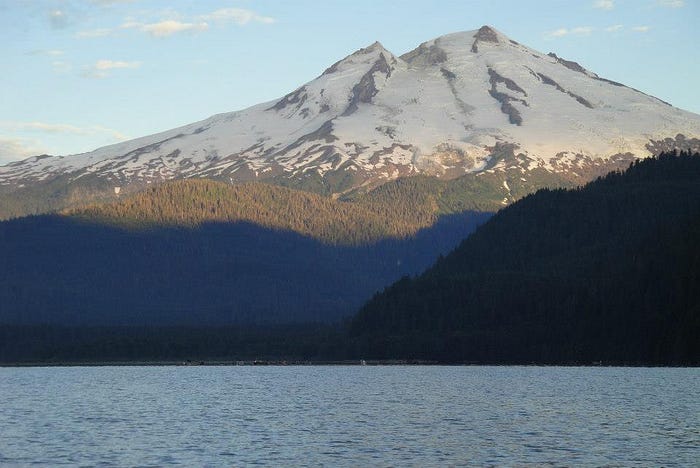‘Great success’: Baker River sockeye reach record number

A version of this article was originally published by Northwest Northwest Treaty Tribes. Additional WDFW perspectives are included below. We appreciate our co-managers for their work on Baker sockeye as well as collaboration on this story.
A record number of Baker River sockeye are making their way upriver this year.
The sockeye co-managers — consisting of the Upper Skagit and Swinomish tribes and the Washington Department of Fish and Wildlife (WDFW) — are estimating a total return of more than 65,000 Baker River sockeye for 2023.
The Baker River is a tributary of the Skagit River near Concrete, Washington.
The sockeye run, which has been gradually on the upswing from a low of less than 100 fish in 1985, has already exceeded the previous record of 51,074 fish trapped and harvested in 2015.
Fish captured in the upstream fish trap at the Lower Baker River Dam operated by Puget Sound Energy (PSE) are used to fulfill broodstock needs at the hatchery or are released to allow natural spawning and, when enough fish are available, recreational fishing opportunity on Baker Lake.

This year, more than 14,000 of the fish were intercepted at the upstream fish trap by July 4 — a tally WDFW called an “unprecedented number of early returning fish.” During July, the number of sockeye trapped surpassed the previous record of 32,736 during the entire 2015 season, with nearly 39,000 fish trapped during the single month.
This allowed WDFW and tribal co-managers to increase fishing opportunities this year. Recreational fishing on Baker Lake opened a week early on July 8 and, a week later, the limit was increased from three fish per day to five fish. There was also a popular sockeye fishing derby hosted by the Coastal Conservation Association (CCA) in coordination with WDFW, including 200 tagged fish eligible for prizes.
Treaty tribes also were able to increase their time on the water.
For the Upper Skagit Indian Tribe, the original commercial and subsistence fishery was scheduled for 36 hours over two weeks in early July. The tribe’s fisheries harvest management biologist Bob McClure said the stronger run size enabled the tribe to conduct 144 hours of commercial fishing over three weeks, plus additional cultural and subsistence harvest.
Each day of fishing is celebrated by tribal fishermen.
“Today, we are rich with culture,” said elder Scott Schuyler, the tribe’s natural resources policy representative, as he and family members moved their catch from boat to temporary storage on ice.
During the fishery, up to 25 Upper Skagit fishing boats took turns drifting sections of the river for a matter of minutes per turn. Fishing was concentrated primarily on the abundance of sockeye in the lower Baker River to reduce impacts on the more limited Chinook salmon returns in the mainstem Skagit River.

The sockeye run has for several years been a consistent source of tribal and non-tribal fishing opportunity in the Skagit River watershed. The growth of the population is credited to interventions by the co-managing tribes and WDFW under the 2003 Federal Energy Regulatory Commission license for PSE’s hydroelectric Baker River dams. Those interventions have included the installation of new fish trapping systems for both out-migrating juveniles and returning adults, and the replacement of a hatchery facility.
“The growth of this population is a testament to successful co-management as well as close collaboration with Puget Sound Energy,” said Andrew Fowler, Skagit District fisheries biologist for WDFW. “Together we’ve led operation of the Baker Hatchery, resulting in successful seasons of fruitful fishing opportunities for the state and tribes, and a bright future ahead.”
“The sockeye program has been a great success,” Upper Skagit’s McClure said.
But, he adds, the goals for the salmon population are bigger yet. The goal, which was included in the 2003 PSE license agreement, is to see returns reach up to 100,000 fish.

“Although we are not quite to our 2003 management objective, we are getting closer and Upper Skagit fishers get to have a sockeye fishery at our ancestral village of Sbalikwh, at the mouth of the Baker River, almost every year — a cultural experience that was denied prior to 2003,” Schuyler said.
“With effective collaboration, communication, and trust between Skagit River sockeye co-manager Tribes, WDFW, and PSE over the past decade, a strong foundation has been built for Baker Lake sockeye recovery,” says Dr. Mickey Agha, WDFW’s Salmon Science Policy Analyst.
“The record return in 2023 marks the fourth year in a row that the Baker sockeye run has outpaced pre-season expectations and continued to grow,” continued Dr. Agha. “Despite the recent outstanding success in the Baker system, sockeye in the Pacific Northwest continue to be confronted by a variable ocean climate and challenging freshwater conditions. As such, sockeye managers will continue to analyze survival trends and changing environmental conditions, evaluate broodstock goals and migration timing, and bring a conservation-minded approach to ensure we continue to see a sustainable return of Baker sockeye into the future.”

To continue growing the fish population may require increased hatchery production and habitat restoration to support more natural spawning. Research is ongoing to determine the most appropriate next steps.
In the meantime, co-managers await the final 2023 run size tally. From June through August, 65,101 sockeye returned, including those that were harvested and those that passed through the upstream fish trap. Additional sockeye may continue to arrive at the trap through mid-October, according to WDFW.
The Baker River program has been so successful that Baker sockeye are now being transported to the Skokomish River for use as broodstock to jumpstart a recovery program led by the Skokomish Tribe and Tacoma Power with support from WDFW. The hope is this effort will replicate the success seen in the Skagit Watershed and create future fishing opportunities, including in Lake Cushman.

